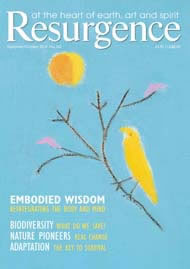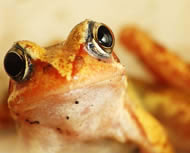In 2002 the world committed itself to arresting the decline of biodiversity by 2010. Perhaps that was an ambition to change the way we think about Nature rather than a realistic target, but anyway it didn’t work. The erosion of biological diversity is happening faster than climate change around the world and yet has far less political purchase. This may have something to do with language: biodiversity is the variety of life, and in our culture we have learned to associate variety with choice. Can we do without certain species? Can we favour some species over others? In conservation, does the end ever justify the means?
Scientists may reject the questions but it’s their term ‘biodiversity’ that makes space for them. Forcing ‘biological’ and ‘diversity’ into ‘biodiversity’ leaves out the ‘logical’ to produce an opaque term filled with values, which, in the more intimate, public language of Nature, creates doubt about what it really means. Biodiversity has inadvertently become a ‘quantitative view of life’ and appears the preserve of expert elites who describe it using the language of economics: competition, energy expenditure, strategies and dominance.
What has happened to Nature? For the bean-counters, Nature is primarily a resource, and biodiversity is now hitched to notions such as ‘ecosystem services’ and ‘natural capital’ – both free-market, consumerist ideals.
Meanwhile, as a result of those economic ideals impacting on natural processes, the tragedies of biodiversity spread across the globe. Farming, deforestation, urban development and transport are all huge threats to species and habitats, and then there’s climate change on top of that. And our anxieties about extinction carry the additional guilt of responsibility for the loss of life.
Now the conservation community is engaged in managing ‘the Nature we like’ for fear of ‘the Nature we don’t like’. The environmental orthodoxy claims that native is better than alien, rare is better than common; red squirrels are better than grey squirrels, therefore cull the grey squirrels. This kind of management is fraught with ethical questions that are being answered in ways that would be unconscionable in any other form of human endeavour.
Here is one of the most challenging and poignant examples. On a visit to Robinson Crusoe Island, I was eagerly anticipating endemic plants, cloud forest and a unique biodiversity. But what struck me first was a dusty moonscape flowering with big red poppies and bright yellow marigolds – the familiarity of the flowers only heightening the strangeness of the scene.
Named after Defoe’s famous novel (said to have been inspired by the Scottish mariner Alexander Selkirk, who was a castaway on this island for four years from 1704), Robinson Crusoe Island is the largest of the Juan Fernández archipelago. The cliffs of its extinct volcanoes soar 1,620m (5,300ft) above the ocean and are covered with a unique range of vegetation, earning the region the title ‘the Galapagos of plants’.
“This is one of the global jewels of biodiversity,” says Peter Hodum, an ecologist from the University of Puget Sound, USA, who heads up the conservation organisation Oikonos. “Although it does not have the cachet of the Galapagos, it is just as important.”
According to island biology expert Tod Stuessy, from the University of Vienna’s Faculty Centre of Biodiversity, its plant life has evolved to produce such vegetation that “the Juan Fernández islands are a bio-geographic puzzle, a unique place to test evolutionary hypotheses, and a symbol for conservation. We all have a responsibility for its stewardship.”
‘Stewardship’ is an important idea in Nature conservation, but there is also a kind of stewardship that has changed the ecology of the islands. In 1540, the discoverer of this archipelago dropped off four goats to provide food for future mariners. Unlike Selkirk, who was eager to be rescued, people came to Robinson Crusoe Island to stay: pirates, political prisoners and, in the 19th century, colonists. There are now 600 people living in the pretty village of San Juan Bautista, sustained by lobster fishing and livestock in a garden paradise.
But carving such an idyll from this wilderness has profound ecological consequences. Overgrazing by goats, cattle, sheep, horses and rabbits has led to irreversible erosion. Rats and mice jumped ship to become predators of endemic birds and gnawers of rare plants, some species of which are down to one lone survivor. New plants arrived with immigrants, and flowers skipped over garden fences to colonise disturbed land and oust vegetation that had evolved over four million years.
The population of the Juan Fernández firecrown – a hummingbird adapted to the pristine forest, and one of the rarest birds in the world – was thought to have plunged to 400 individuals because only 10% of the forest where it feeds on insects and nectar has survived overgrazing, erosion and replacement by introduced plants (such as the European blackberry) which don’t have the kind of flowers the firecrown needs. Thanks to conservation programmes and the planting of native shrubs in village gardens, the firecrown numbers are back up to 2,000–3,000 individuals, but when they come into the village to find food they are now vulnerable to attack by cats.
Of the 123 endemic plant species on the archipelago, five are now declared extinct, 72 endangered and rare, 21 endangered and 21 vulnerable. A further 14 species have less than 10 individuals left in the wild. Saddest of all, perhaps, is the tale of the cloud-forest flowering shrub Robinsonia berteroi: the last of its kind was gnawed by a rat and as a result an entire species has gone forever.
The unique ecology of the Juan Fernández Islands faces irreversible change, which the international conservation community and islanders see as a catastrophe. What is happening here is being repeated all over the world: habitats are lost and species face extinction. The islands are a microcosm of the tragedy of biodiversity and offer a graphic account of rapid change through human settlement in vulnerable ecosystems. Because of this, the values implicit in biodiversity draw us into an adversarial conflict with Nature.
The term ‘biodiversity’ celebrates difference between things rather than the things themselves. It may be that diversity is strength and that we need it to sustain ourselves and be what we are. Although all living things depend on the relationships between them for their existence, it is hard to care for abstract ideas of diversity, especially when our impulse is to love the particular: this fern, this bird, this seal.
Valuing diversity itself may not discriminate between which kind of living thing we love and which we persecute. To discriminate, using scientific conservation values such as ‘nativeness’, rarity, threat and vulnerability, ceases to be neutral.
We are told that we stand on the brink of mass extinctions and that the imperative is to act to save biodiversity. “Shoot the goats, poison the rats, grub out the bramble,” was the consensus of a recent conference of conservation scientists on the Juan Fernández archipelago. Alan Saunders, who leads New Zealand’s invasive-species management programme, is optimistic about protecting endemic species on the Juan Fernández Islands from ‘invasive aliens’: “They say you can’t turn the clock back but I say we can get awful close in restoring islands to their previous state. We’ve eradicated introduced species from New Zealand islands and we can have a good go with this.”
In a way, stewardship has become a way of reconciling the ethical dilemmas of the ends justifying means. “The important thing about this biodiversity is that it has a meaning for itself but it’s up to us to take care of it,” says Ivan Julio Leiva Silva, Director of Juan Fernández National Park.
“It’s not pretty work,” says Peter Hodum of Oikonos, “but it is essential to save these endemic species.” And many in the local community back such measures. “We must act now,” says one islander. “Our islands are dying.”
Engaging the local community has been central to the success of conservation. Similar projects appear around the world, and the UK government supports rat eradication on Ascension Island for similar reasons. The increasing desperation about biodiversity makes these management measures more drastic, but because the debate is controlled by an expert elite using a very specific language, its ethics and practices are not being scrutinised publicly.
The kind of care given to biodiversity is managerial, a ‘standing-in’ for Nature. It stems from a desire to control, to garden, and is adversarial towards natural processes, such as the colonisation of animals and plants that cause long-term change to the preferred model of biodiversity. Management is antithetical to wildness, and even if pristine wilderness is little more than a romantic ideal, caring for the qualitative ‘wild’ of wildlife is a hands-off advocacy, a standing-up for Nature to be as it is, even if we think that that’s bad for us.
These differing visions of Nature can be hard to reconcile, particularly when standing in a forest on Robinson Crusoe Island with firecrowns singing from the white-flowered luma trees, and unique ferns at every step, watching the advance of the smothering acres of European bramble wipe out four million years of isolated evolution. Extinction, after all, is not relative. But then, is imposing the future based on human preferences as justifiable as the scientists seem to assume?
Creating order in Nature is always oppressive to something, and interventions tend to be a temporary holding-back until attitudes or natural processes change. For conservation to become a cultural project it must involve everyone and not just a professionalised elite with specialised language and self-appointed rights.
This year – The International Year of Biodiversity – demonstrates that the focus on ‘diversity’ will not in itself help life on Earth. We need a partisan advocacy for non-human life, to stand up for the whole of Nature, not just those bits of it privileged by experts. We can reclaim a public language of Nature that is not an adversarial choosing between kinds of diversity. We can support communities that make a difference. Together we can help inspire international efforts at least as urgent and comprehensive as those dealing with climate change.








